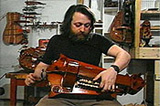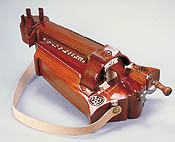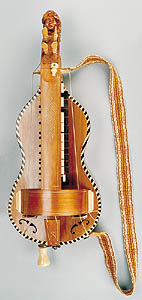
| Opus 14 - Hurdy-Gurdy |
|
|
In the eighteenth century, it became the preeminent musical symbol of pastoral life, a reflection of high society's fancy for nature. Writers of that era attempted to ennoble the instrument's origins, just as its appearance was dignified by the addition of mother-of-pearl, ebony and ivory inlays, and sculpted heads. Today, the hurdy-gurdy is used in early-music ensembles or to play traditional music. The instrument is found throughout Europe, including France, Germany, Hungary, Italy, Poland and Scandinavia. Daniel Thonon based this hurdy-gurdy on an eighteenth-century French instrument. The tortoise-shaped body and, in particular, the head evoke the Arab style much favoured at the court, where the fashion was to dress up as a sultan or Persian princess for celebrations. Following tradition, the luthier glued an inscription inside the keyboard cover: "This hurdy-gurdy, the thirteenth to come out of my workshop, was ordered by the Canadian Museum of Civilization. By sorry coincidence, it was begun and completed at the same time, to the day, as the so-called 'Gulf War,' which is not, however, a tribute to our civilization. One hundred days, twenty-three keys, one friction wheel, forty-six jacks, and thousands of deaths. Daniel Thonon, Saint-Marc-sur-Richelieu, Quebec, February 1991" [translation from French]. Daniel Thonon 
Daniel Thonon Saint-Marc-sur-Richelieu, Quebec 1991 Although Daniel Thonon specializes in hurdy-gurdies, he makes other early instruments, such as the rebec, vithele, psaltery, crwth and lute, and also restores all types of stringed instruments, including the harpsichord, pianoforte and clavichord. As a musician and composer-arranger, he is eager to promote awareness of the hurdy-gurdy and its repertoire. In addition to conducting workshops, he is president of the traditional music ensemble "Ad vielle que pourra", and one of the organizers of the "Vielles et cornemuses" festival, an annual event for fans of Quebec, French, Irish and Breton music. Born in Brussels, Thonon was surrounded by music from an early age as his father was a jazz pianist. He studied the harpsichord at the Geneva Conservatory and the making of harpsichords and early instruments at the Conservatoire de Paris. His interest in medieval music led him to study its origins in Arab-Andalusian music at the Conservatoire de Tlemcen in Algeria. After settling in Quebec in 1977, he continued to be very musically active and, for some time, was a member of the Claude Gervaise ensemble. To date, Daniel Thonon has made over twenty hurdy-gurdies for a broad range of musicians, including the band Pink Floyd, which owns three of his instruments.
This hurdy-gurdy is a reproduction of an anonymous eighteenth-century instrument owned by Paul Reichlin of Samstagern, Switzerland. It also resembles an instrument in the collection of the Conservatoire national de Paris made by Pierre Louvet (1711-84), a renowned hurdy-gurdy maker. The guitar-shaped body is made of cherrywood. With its carved head and ebony and holly inlays on the purfling of the body, this instrument is a model of craftsmanship. The strap was woven by Edward Turner. |
 |



